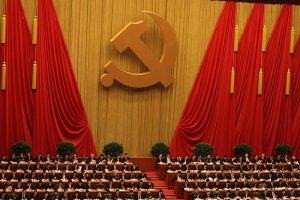The rise in tourism, commercialization, and development in recent years has left Zhangjiajie National Forest Park (ZNFP) with several environmental consequences (read more here).

Despite scientific research in the area and noticeable changes in the environmental landscape of the park, there has been little public outcry to try and maintain the integrity of ZNFP. There are, however, some examples of times when international environmental agencies have stepped up to try and protect ZNFP.
The World Conservation Union (UNESCO) and International Union for Conservation of Nature (IUCN)

Beginning as early as 1998, UNESCO and the IUCN have repeatedly warned ZNFP of the irreparable harm that tourism and development in the area is causing. ZNFP first drew the attention of UNESCO and IUCN officials back in 1992 when a private investor proposed building a controversial, 325 meter steel elevator on the side of a cliff (Zhong, Dang, & Ziang, 2007).
Despite major fears by environmental academics since the project would require drilling holes in rocks, the construction commenced due to its economic benefits(Zhong, Dang, & Ziang, 2007). After a site visit in 1998, ZNFP received official warnings from both UNESCO and IUCN for building numerous new hotels and commercial retail outlets in the park (Wang et al., 2012).
Park officials announced in 2001 that following the UNESCO and IUCN warnings, they implemented new regulations for Wulingyuan World Heritage Site (which ZNFP is a part of) (Wulingyuan Scenic Resort Administrative Department, 2002). The exact details of the legislation are unknown, but ZNFP did show signs of improvement from 1998 after demolishing several hotels and commercial buildings (Wang et al., 2012).
As of 2013, one article reports that UNESCO has once again warned and placed ZNFP on a “yellow card warning”. This means if the conditions do not improve within 2 years, their membership as a world heritage site could be revoked (China24, 2013).
Possible Reasons for Lack of Activism
Aside from international reprimanding, there has been little to no activism within the park. This may be due to issues of power and privilege, since government officials and local villagers often rely on tourism in the area and investments from the private sector for their livelihood.

While international, western run environmental agencies like UNESCO and IUCN were able to help in the short term, when it comes down to it the financial benefits of tourism for China’s economy constantly trump the environmental concerns.
Citations:
[Bobohk2]. (2013). Zhangjiajie Mountain Elevator [Photograph]. Wikimedia. Retrieved November 15, 2016 from https://commons.wikimedia.org/wiki/File:Zhangjiajie_mountina_elevator.jpg
[China24]. (2013, Jan 20). Three Chinese geoparks given UNESCO warning. Retrieved from http://english.cntv.cn/program/china24/20130120/101557.shtml
Fang, D. (2012). 18th National Congress of the Communist Party in China [Photograph]. Wikimedia. Retrieved December 6, 2016 from https://commons.wikimedia.org/wiki/File:18th_National_Congress_of_the_Communist_Party_of_China.jpg
[IUCN Logo]. Retrieved December 6, 2016 from https://commons.wikimedia.org/wiki/File:IUCN_logo.svghttps://commons.wikimedia.org/wiki/File:IUCN_logo.svg
[UNESCO Logo]. Retrieved December 6, 2016 from https://upload.wikimedia.org/wikipedia/commons/thumb/b/b7/UNESCO_logo_green.svg/1000px-UNESCO_logo_green.svg.png
Wang, G.,Innes, J. L., Wu, S.Vy’., Krzyzanowski, J., Yin, Y., Dai, S., . . . Liu, S. (2012). National park development in China: Conservation or commercialization. Ambio, 41 (3), 247 -261. doi: 10.1007/s13280-011-0194-9
Wulingyuan Scenic Resort Administrative Department. (2002). Periodic report: The state of conservation of the World Natural Heritage: Wulingyuan. Zhangjiajie City, Hunan Province, China: Author. Retrieved from http://whc.unesco.org/archive/periodicreporting/apa/cycle01/section2/640.pdf
Zhong, L., Dang, J., & Ziang, B. (2007). Tourism development and the tourism area lifecycle model: A case study of Zhangjiajie National Forest Park, China. Tourism Management, 1(16). doi: 10.1016/j.tourman.2007.10.002
